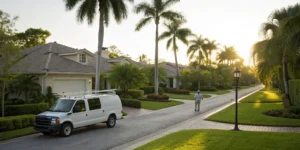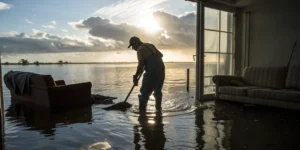Imagine waking up to a foot of water in your living room after a night of torrential rain. Your first thought after ensuring your family is safe is likely, “Am I covered?” For millions of homeowners, the answer to that question is a shocking and devastating surprise.
The short answer is no, a standard homeowner’s insurance policy almost never covers damage from a flood.
In this article, you’ll learn why standard policies exclude floods, the critical difference between “water damage” and “flood damage,” what dedicated flood insurance is and what it covers, and how to find out if you need it—hint: you probably do.
The Big Reveal: Why Standard Policies Don’t Cover Floods
The reason flood damage isn’t covered by your homeowner’s insurance comes down to a fundamental insurance principle: widespread catastrophic events. When a flood occurs, it doesn’t just affect one home—it impacts entire neighborhoods, towns, or even regions simultaneously. This creates a level of financial risk that’s simply too high for standard insurance policies to bear. If every home in a community filed a claim at once, it could bankrupt insurance companies.
Because of this extraordinary risk, flood damage is specifically excluded from most homeowner’s insurance contracts, including the common HO-3 policy that most Americans carry. If you check your policy documents, you’ll find flood damage listed as a named exclusion. This isn’t an oversight or a loophole—it’s an intentional design of how homeowner’s insurance works.
Flood Damage vs. Water Damage: A Crucial Distinction
This is where many homeowners get confused, and understanding the difference could save you from a costly surprise. Not all water damage is created equal in the eyes of your insurance policy.
What is Flood Damage?
According to the National Flood Insurance Program (NFIP), flood damage is defined as “an excess of water on land that is normally dry, affecting two or more acres of land or two or more properties.” In simpler terms, it’s water that comes from outside your home and invades your property.
Examples of flood damage include:
- River or creek overflow after heavy rain
- Storm surge from hurricanes or tropical storms
- Flash floods from severe weather
- Accumulated rainwater that enters your home from ground level
- Snowmelt that causes water to rise
Coverage status: NOT covered by standard homeowner’s insurance.
What is Water Damage?
Water damage, on the other hand, refers to damage caused by water that originates inside your home due to a sudden and accidental event. This is the type of water-related damage your homeowner’s policy was designed to address.
Examples of water damage include:
- A burst pipe in your walls or ceiling
- An overflowing toilet or washing machine
- A leaking water heater
- A malfunctioning dishwasher
- Ice dam damage on your roof
Coverage status: Typically COVERED by homeowner’s insurance (though you’ll usually need to pay for repairing the source of the leak, like replacing the burst pipe itself).
The key distinction? If the water comes from outside and flows onto normally dry land, it’s a flood. If it originates from your home’s plumbing or appliances, it’s water damage.
The Solution: Getting Covered with Dedicated Flood Insurance
Since your homeowner’s insurance won’t protect you from floods, you need a separate policy specifically designed for this purpose. There are two main ways to get flood protection.
The National Flood Insurance Program (NFIP)
The NFIP is a federal program managed by FEMA (Federal Emergency Management Agency) and is the most common source of flood insurance in the United States. The vast majority of flood policies in America are written through this program, making it the backbone of flood protection for homeowners.
The NFIP offers coverage with these standard limits for residential properties:
- Up to $250,000 for the building structure
- Up to $100,000 for personal contents and belongings
These policies are sold through private insurance companies and agents but are backed by the federal government, which means you’re getting the stability of a government program with the convenience of working through your existing insurance provider.
Private Flood Insurance
In recent years, private flood insurance has emerged as an alternative or supplement to the NFIP. Private insurers are now offering flood policies that can sometimes provide advantages over the government program.
Potential benefits of private flood insurance include:
- Higher coverage limits beyond the NFIP caps
- Potentially faster claims processing
- More flexible coverage options
- In some cases, lower premiums depending on your property and location
Your insurance agent can help you compare NFIP and private options to determine which is best for your situation—or whether a combination of both makes sense for maximum protection.
Do I Really Need Flood Insurance?
Many homeowners assume they don’t need flood insurance because they “don’t live in a flood zone.” This is one of the most dangerous misconceptions in home insurance. Let’s break down the reality.
If You Live in a High-Risk Zone (SFHA)
If your property is located in a Special Flood Hazard Area (SFHA)—also known as a high-risk flood zone—and you have a federally backed mortgage, you are legally required to carry flood insurance. Your lender won’t give you a choice, and for good reason: these areas have a significant chance of flooding.
You can check your property’s flood zone designation by visiting the FEMA Flood Map Service Center and entering your address. This free tool will show you your current flood risk rating.
If You Live in a Low-to-Moderate Risk Zone
Here’s the statistic that should concern every homeowner: more than 25% of all NFIP flood claims occur in areas outside of high-risk flood zones. Let that sink in. One in four flood claims comes from areas that people assume are “safe.”
Why does this happen? Several factors are at play:
- Changing weather patterns are making severe rain events more common and unpredictable
- Urban development alters natural drainage patterns, sending water into areas that never flooded before
- Infrastructure limitations mean that storm drains and sewers can become overwhelmed
- Minor flooding is still catastrophic because even just a few inches of water can cause $25,000 or more in damage to your home
The truth is that if it can rain where you live, you have flood risk. The question isn’t whether you’re at risk—it’s how much risk you’re willing to take with potentially the largest investment of your life.
How to Get a Flood Insurance Policy
Ready to protect your home? Here’s exactly what you need to do.
Step 1: Contact Your Insurance Agent
Your current homeowner’s or auto insurance provider can almost certainly sell you an NFIP flood policy. Give them a call or send an email to start the conversation. If you prefer to explore private flood insurance, your agent can help with that as well or refer you to a specialist.
Step 2: Get a Quote
Work with your agent to determine the right coverage levels for your needs. You’ll need to decide on coverage amounts for both your building structure and your personal contents. Consider factors like your home’s value, how much your belongings are worth, and whether you have a basement (which has special coverage considerations).
Step 3: Don’t Wait!
Here’s the most important thing to know: most new NFIP flood insurance policies have a 30-day waiting period before they take effect. You cannot buy a policy when a storm is already heading your way and expect to be covered. You need to plan ahead.
This waiting period exists to prevent people from only buying insurance when they know a flood is coming. It means that the best time to get flood insurance is right now, before you need it. Once the forecast shows heavy rain or a storm approaching, it’s already too late.
Don’t Be Surprised—Be Prepared
Let’s review what you’ve learned:
First, your standard homeowner’s insurance policy does not cover flood damage. This is a specific exclusion in nearly every policy, and it’s not going to change. Second, you need a separate flood insurance policy through either the National Flood Insurance Program or a private insurer to be protected. Third, every homeowner should seriously assess their flood risk, regardless of whether they live in an official high-risk zone, because more than 25% of claims come from “low risk” areas.
The cost of flood damage can be absolutely devastating—both financially and emotionally. But the cost of protection is manageable, often costing less per month than your streaming subscriptions. Don’t wait for the water to rise.
Contact our team of experts today for a free, no-obligation flood insurance quote and protect your home and your peace of mind. The 30-day waiting period means tomorrow might already be too late—take action now.
Frequently Asked Questions
How much does flood insurance cost?
The cost of flood insurance varies significantly based on your property’s flood risk, location, the coverage amount you choose, and your deductible. However, the national average for NFIP policies is around $700 per year. Properties in low-to-moderate risk zones often pay much less—sometimes as little as $400-500 annually. High-risk properties or those requiring substantial coverage can pay significantly more. The only way to know your actual cost is to get a personalized quote based on your specific property.
Does flood insurance cover basement damage?
Flood insurance coverage for basements is limited. The policy will cover structural elements of the basement, such as the foundation walls, and essential systems like your furnace, water heater, and electrical panels. However, finished basement improvements like drywall, flooring, carpeting, and personal belongings stored in the basement are generally not covered. If you use your basement as living space or for storage, you need to understand these limitations.
Is there a waiting period for flood insurance?
Yes, most new NFIP flood insurance policies have a 30-day waiting period before coverage begins. There are some exceptions—for example, if you’re buying flood insurance because it’s required for a new mortgage, the waiting period may be waived. However, you should always assume that any policy you purchase today won’t protect you for a full month. This is why it’s crucial to buy flood insurance before storm season, not during it.
What if a pipe bursts and floods my house? Is that a flood?
No, a burst pipe is not considered flood damage—it’s water damage, and it’s typically covered by your standard homeowner’s insurance policy. Remember the key distinction: flood damage comes from water outside your home that accumulates on normally dry ground and then enters your property. A burst pipe originates inside your home’s plumbing system, so it falls under the water damage coverage in your homeowner’s policy. Your insurer will likely cover the resulting damage (though you may need to pay to repair or replace the pipe itself, and you’ll owe your deductible).
Don’t Wait For The Storm. The 30-day Clock is Ticking.
Most flood insurance policies have a 30-day waiting period. By the time a storm is in the forecast, it’s already too late. Protect your home and your financial future by acting now. Contact SuperClean Restoration Services for help.
Call for a Free Quote Today: 844-888-0837
Email Our Insurance Experts: Info@supercleanrestorationpb.com




